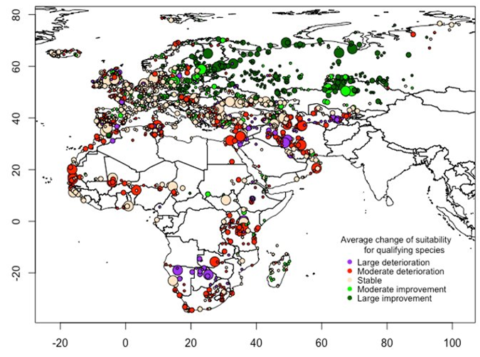
New study predicts that African waterbirds will suffer from climate change
-
Climate and disaster risks
-
Community resilience
-
Species
Wetlands International and BirdLife International have launched results of a major climate impact study at the 7th Meeting of the Parties (MOP7) of the UNEP African-Eurasian Migratory Waterbirds Agreement (AEWA) in Durban, South Africa. This new study, which is a part of our Climate Resilient Flyway project, shows that many High Arctic breeding waders and African waterbirds are predicted to suffer more from the impacts of climate change than the European ones. Therefore it is essential that their freshwater habitats are safeguarded and managed as climate buffer as much as possible.
We worked with the Universities of Kassel, McGill, Lausanne and Wisconsin to predict the changes in monthly discharge and inundation of rivers till 2050, and changes in the distribution of suitable climatic conditions for 247 waterbird species in the African-Eurasian flyway. The researchers also investigated how sites, that are currently internationally important for waterbirds, will be affected by climate change. They also examined how well the network of such sites will be able to support the anticipated shifts in the range of High Arctic waders and waterbirds in Africa. The results of this research were launched at the 7th meeting of parties of AEWA to the delegates from over 70 countries from the flyway.

“Worryingly, species breeding in Africa and the Middle East will suffer major losses of suitable habitat across their ranges, while most species breeding in the temperate zone of Europe will be able to respond to climate change by shifting their distributions,” says Frank Breiner, the modeler at Wetlands International.
Dr. Stuart Butchart, Chief Scientist at BirdLife International and a collaborator on the study, echoes this concern: “Freshwater wetlands are among the most highly threatened ecosystems on the planet, and climate change will only exacerbate these threats. Concerted action is urgently needed to conserve them effectively, focusing on critical sites which are of international significance for waterbirds including Important Bird and Biodiversity Areas and taking into account the projected impacts of climate change for each species at each site.”
Such massive concern calls for a landscape-scale solution. While reflecting on a possible solution, Merijn van Leeuwen, manager of the Climate Resilient Flyway project, of which the study is part, observes, “Climate change adaptation for waterbirds in Africa is not realistically possible without integrating the requirements of birds into ecosystem-based adaptation for humans. In practice, this means that we need to integrate our understanding of ecological requirements into national policies and landscape scale plans for land use and water management.”

Based on the latest climate change models and data, these studies reveal a disconcerting future for waterbirds in Africa and for High-Arctic specialist breeders. These predicted decreases can be prevented only through an unprecedented collaboration across sectors within the landscape, among communities, companies, and government. Wetlands International urges countries to join forces in establishing an alliance for a Climate Resilient Flyway at the AEWA MOP and beyond.
About Climate Resilient Flyways
The project aims to contribute to the establishment of a coherent and climate resilient network of protected or otherwise managed areas by assessing the vulnerability of Critical Sites for waterbirds (identified under the Wings Over Wetlands: African-Eurasian Flyway Project), the cumulative effect of climate change on waterbird populations at the level of the African-Eurasian flyway, and demonstrate the implementation of the AEWA Resolution 5.13 on climate change adaptation at national and site level in Mali and Ethiopia. The project is funded by the International Climate Initiative on the basis of a decision adopted by the German Bundestag.
About Critical Site Network tools
The tool makes it easy to obtain information on the sites critical for waterbird species by accessing several independent databases and analysing information at the biogeographical population level, so providing a comprehensive basis for management and decision making. It is designed to help a range of different users from site managers to national authorities and international organisations. The CSN Tool, one of the major achievements of the Wings Over Wetlands (WOW) project, is also an important example of the added value of cooperation between like-minded conservation organisations, international conventions and agreements, governments, UN agencies and other donors.
